Management of Change
VerifiedAdded on 2022/12/19
|15
|3791
|1
AI Summary
This document discusses the nature of Lakeland Wonders organizational change project, the appropriateness of the change approach, gaps in the approach and recommendations for a different approach, McKinsey 7S framework analysis, and organizational culture in the Lakeland Wonders case.
Contribute Materials
Your contribution can guide someone’s learning journey. Share your
documents today.

Running head: MANAGEMENT OF CHANGE
MANAGEMENT OF CHANGE
Name of the student
Name of the university
Author note
MANAGEMENT OF CHANGE
Name of the student
Name of the university
Author note
Secure Best Marks with AI Grader
Need help grading? Try our AI Grader for instant feedback on your assignments.
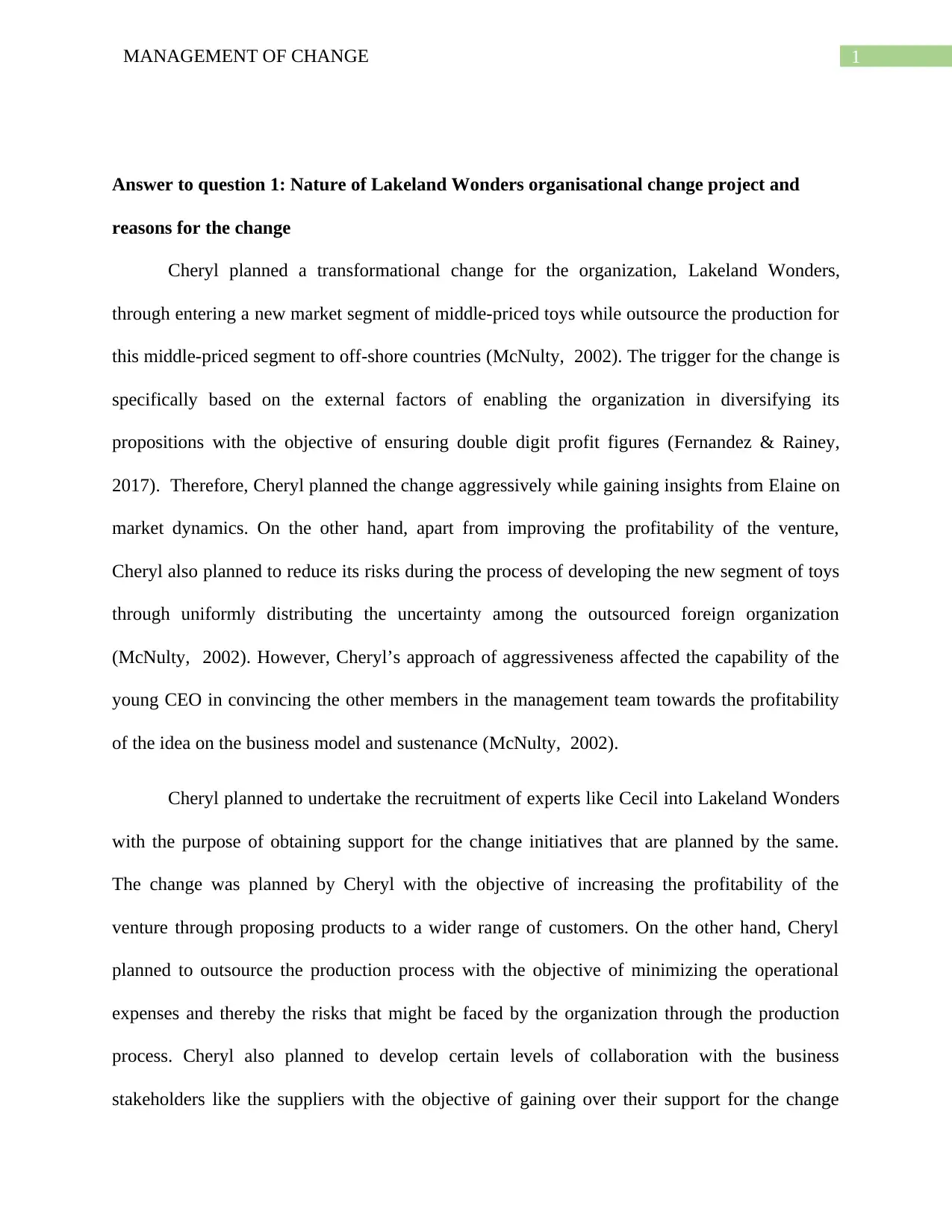
1MANAGEMENT OF CHANGE
Answer to question 1: Nature of Lakeland Wonders organisational change project and
reasons for the change
Cheryl planned a transformational change for the organization, Lakeland Wonders,
through entering a new market segment of middle-priced toys while outsource the production for
this middle-priced segment to off-shore countries (McNulty, 2002). The trigger for the change is
specifically based on the external factors of enabling the organization in diversifying its
propositions with the objective of ensuring double digit profit figures (Fernandez & Rainey,
2017). Therefore, Cheryl planned the change aggressively while gaining insights from Elaine on
market dynamics. On the other hand, apart from improving the profitability of the venture,
Cheryl also planned to reduce its risks during the process of developing the new segment of toys
through uniformly distributing the uncertainty among the outsourced foreign organization
(McNulty, 2002). However, Cheryl’s approach of aggressiveness affected the capability of the
young CEO in convincing the other members in the management team towards the profitability
of the idea on the business model and sustenance (McNulty, 2002).
Cheryl planned to undertake the recruitment of experts like Cecil into Lakeland Wonders
with the purpose of obtaining support for the change initiatives that are planned by the same.
The change was planned by Cheryl with the objective of increasing the profitability of the
venture through proposing products to a wider range of customers. On the other hand, Cheryl
planned to outsource the production process with the objective of minimizing the operational
expenses and thereby the risks that might be faced by the organization through the production
process. Cheryl also planned to develop certain levels of collaboration with the business
stakeholders like the suppliers with the objective of gaining over their support for the change
Answer to question 1: Nature of Lakeland Wonders organisational change project and
reasons for the change
Cheryl planned a transformational change for the organization, Lakeland Wonders,
through entering a new market segment of middle-priced toys while outsource the production for
this middle-priced segment to off-shore countries (McNulty, 2002). The trigger for the change is
specifically based on the external factors of enabling the organization in diversifying its
propositions with the objective of ensuring double digit profit figures (Fernandez & Rainey,
2017). Therefore, Cheryl planned the change aggressively while gaining insights from Elaine on
market dynamics. On the other hand, apart from improving the profitability of the venture,
Cheryl also planned to reduce its risks during the process of developing the new segment of toys
through uniformly distributing the uncertainty among the outsourced foreign organization
(McNulty, 2002). However, Cheryl’s approach of aggressiveness affected the capability of the
young CEO in convincing the other members in the management team towards the profitability
of the idea on the business model and sustenance (McNulty, 2002).
Cheryl planned to undertake the recruitment of experts like Cecil into Lakeland Wonders
with the purpose of obtaining support for the change initiatives that are planned by the same.
The change was planned by Cheryl with the objective of increasing the profitability of the
venture through proposing products to a wider range of customers. On the other hand, Cheryl
planned to outsource the production process with the objective of minimizing the operational
expenses and thereby the risks that might be faced by the organization through the production
process. Cheryl also planned to develop certain levels of collaboration with the business
stakeholders like the suppliers with the objective of gaining over their support for the change
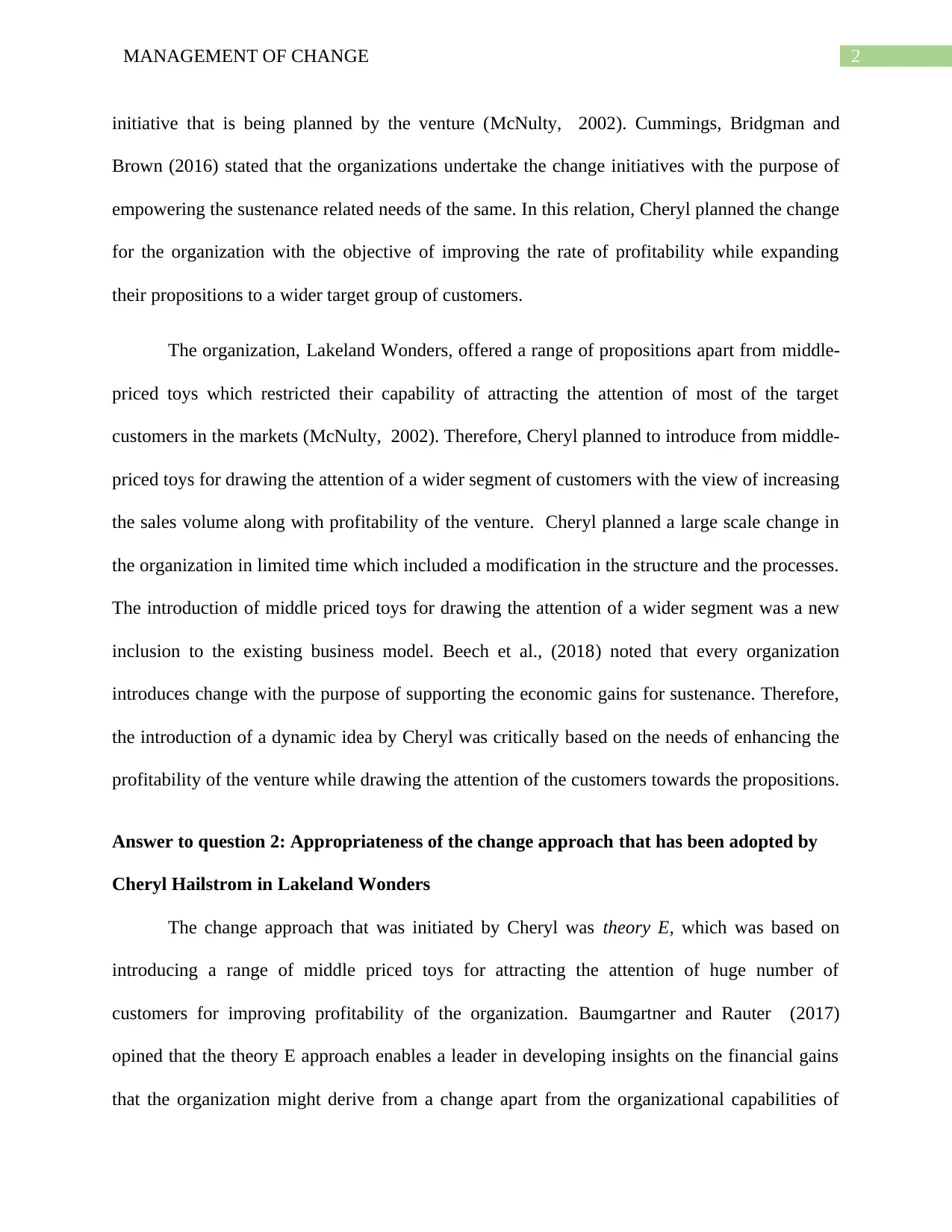
2MANAGEMENT OF CHANGE
initiative that is being planned by the venture (McNulty, 2002). Cummings, Bridgman and
Brown (2016) stated that the organizations undertake the change initiatives with the purpose of
empowering the sustenance related needs of the same. In this relation, Cheryl planned the change
for the organization with the objective of improving the rate of profitability while expanding
their propositions to a wider target group of customers.
The organization, Lakeland Wonders, offered a range of propositions apart from middle-
priced toys which restricted their capability of attracting the attention of most of the target
customers in the markets (McNulty, 2002). Therefore, Cheryl planned to introduce from middle-
priced toys for drawing the attention of a wider segment of customers with the view of increasing
the sales volume along with profitability of the venture. Cheryl planned a large scale change in
the organization in limited time which included a modification in the structure and the processes.
The introduction of middle priced toys for drawing the attention of a wider segment was a new
inclusion to the existing business model. Beech et al., (2018) noted that every organization
introduces change with the purpose of supporting the economic gains for sustenance. Therefore,
the introduction of a dynamic idea by Cheryl was critically based on the needs of enhancing the
profitability of the venture while drawing the attention of the customers towards the propositions.
Answer to question 2: Appropriateness of the change approach that has been adopted by
Cheryl Hailstrom in Lakeland Wonders
The change approach that was initiated by Cheryl was theory E, which was based on
introducing a range of middle priced toys for attracting the attention of huge number of
customers for improving profitability of the organization. Baumgartner and Rauter (2017)
opined that the theory E approach enables a leader in developing insights on the financial gains
that the organization might derive from a change apart from the organizational capabilities of
initiative that is being planned by the venture (McNulty, 2002). Cummings, Bridgman and
Brown (2016) stated that the organizations undertake the change initiatives with the purpose of
empowering the sustenance related needs of the same. In this relation, Cheryl planned the change
for the organization with the objective of improving the rate of profitability while expanding
their propositions to a wider target group of customers.
The organization, Lakeland Wonders, offered a range of propositions apart from middle-
priced toys which restricted their capability of attracting the attention of most of the target
customers in the markets (McNulty, 2002). Therefore, Cheryl planned to introduce from middle-
priced toys for drawing the attention of a wider segment of customers with the view of increasing
the sales volume along with profitability of the venture. Cheryl planned a large scale change in
the organization in limited time which included a modification in the structure and the processes.
The introduction of middle priced toys for drawing the attention of a wider segment was a new
inclusion to the existing business model. Beech et al., (2018) noted that every organization
introduces change with the purpose of supporting the economic gains for sustenance. Therefore,
the introduction of a dynamic idea by Cheryl was critically based on the needs of enhancing the
profitability of the venture while drawing the attention of the customers towards the propositions.
Answer to question 2: Appropriateness of the change approach that has been adopted by
Cheryl Hailstrom in Lakeland Wonders
The change approach that was initiated by Cheryl was theory E, which was based on
introducing a range of middle priced toys for attracting the attention of huge number of
customers for improving profitability of the organization. Baumgartner and Rauter (2017)
opined that the theory E approach enables a leader in developing insights on the financial gains
that the organization might derive from a change apart from the organizational capabilities of
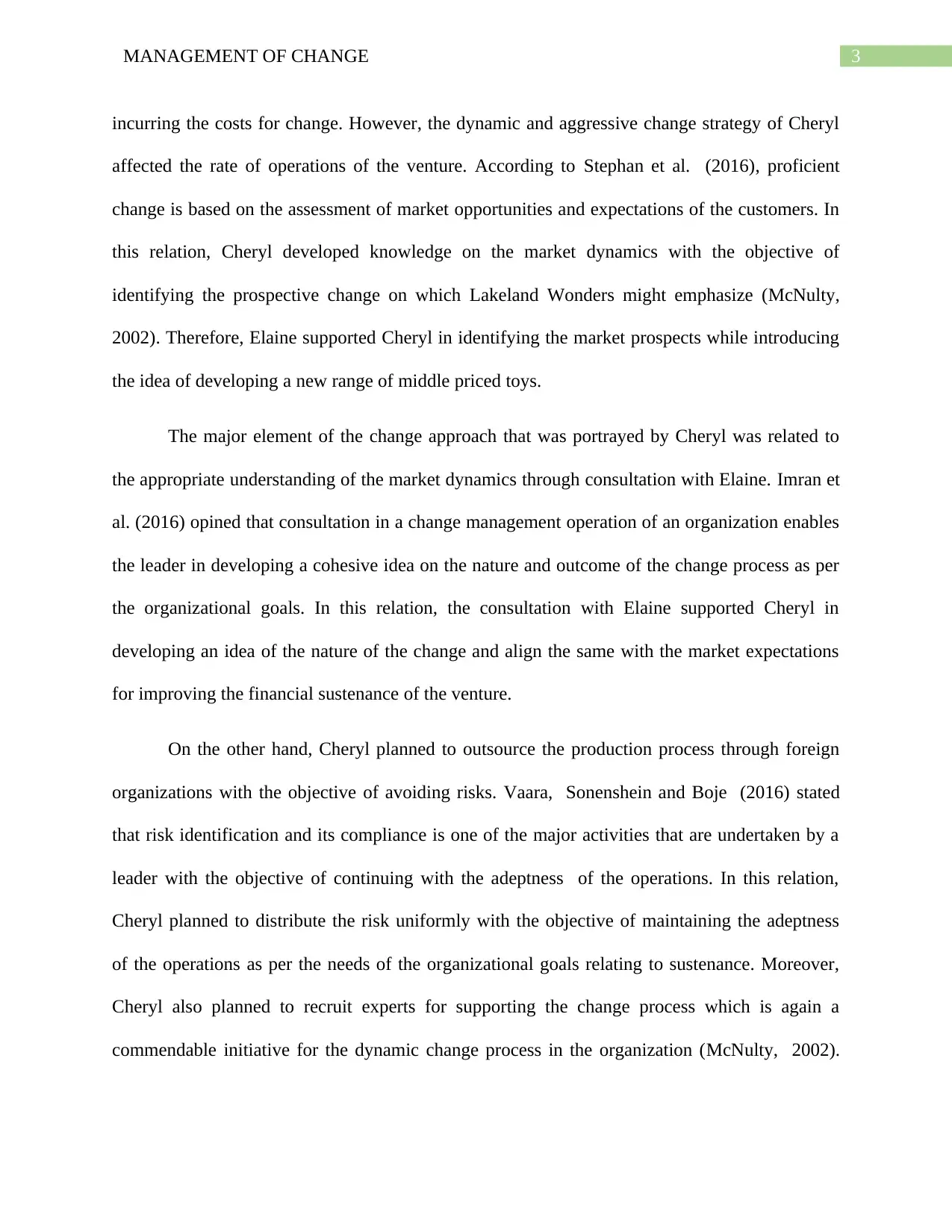
3MANAGEMENT OF CHANGE
incurring the costs for change. However, the dynamic and aggressive change strategy of Cheryl
affected the rate of operations of the venture. According to Stephan et al. (2016), proficient
change is based on the assessment of market opportunities and expectations of the customers. In
this relation, Cheryl developed knowledge on the market dynamics with the objective of
identifying the prospective change on which Lakeland Wonders might emphasize (McNulty,
2002). Therefore, Elaine supported Cheryl in identifying the market prospects while introducing
the idea of developing a new range of middle priced toys.
The major element of the change approach that was portrayed by Cheryl was related to
the appropriate understanding of the market dynamics through consultation with Elaine. Imran et
al. (2016) opined that consultation in a change management operation of an organization enables
the leader in developing a cohesive idea on the nature and outcome of the change process as per
the organizational goals. In this relation, the consultation with Elaine supported Cheryl in
developing an idea of the nature of the change and align the same with the market expectations
for improving the financial sustenance of the venture.
On the other hand, Cheryl planned to outsource the production process through foreign
organizations with the objective of avoiding risks. Vaara, Sonenshein and Boje (2016) stated
that risk identification and its compliance is one of the major activities that are undertaken by a
leader with the objective of continuing with the adeptness of the operations. In this relation,
Cheryl planned to distribute the risk uniformly with the objective of maintaining the adeptness
of the operations as per the needs of the organizational goals relating to sustenance. Moreover,
Cheryl also planned to recruit experts for supporting the change process which is again a
commendable initiative for the dynamic change process in the organization (McNulty, 2002).
incurring the costs for change. However, the dynamic and aggressive change strategy of Cheryl
affected the rate of operations of the venture. According to Stephan et al. (2016), proficient
change is based on the assessment of market opportunities and expectations of the customers. In
this relation, Cheryl developed knowledge on the market dynamics with the objective of
identifying the prospective change on which Lakeland Wonders might emphasize (McNulty,
2002). Therefore, Elaine supported Cheryl in identifying the market prospects while introducing
the idea of developing a new range of middle priced toys.
The major element of the change approach that was portrayed by Cheryl was related to
the appropriate understanding of the market dynamics through consultation with Elaine. Imran et
al. (2016) opined that consultation in a change management operation of an organization enables
the leader in developing a cohesive idea on the nature and outcome of the change process as per
the organizational goals. In this relation, the consultation with Elaine supported Cheryl in
developing an idea of the nature of the change and align the same with the market expectations
for improving the financial sustenance of the venture.
On the other hand, Cheryl planned to outsource the production process through foreign
organizations with the objective of avoiding risks. Vaara, Sonenshein and Boje (2016) stated
that risk identification and its compliance is one of the major activities that are undertaken by a
leader with the objective of continuing with the adeptness of the operations. In this relation,
Cheryl planned to distribute the risk uniformly with the objective of maintaining the adeptness
of the operations as per the needs of the organizational goals relating to sustenance. Moreover,
Cheryl also planned to recruit experts for supporting the change process which is again a
commendable initiative for the dynamic change process in the organization (McNulty, 2002).
Secure Best Marks with AI Grader
Need help grading? Try our AI Grader for instant feedback on your assignments.

4MANAGEMENT OF CHANGE
Cheryl tried to communicate with the suppliers and thereby develop a strong collaboration of the
organization with the stakeholders for empowering the change management process.
Figure 1: Burne’s Change model
(Source: Beech et al., 2018)
According to Burne’s change focus process the different changes that are initiated by the
organizations are related to the focus of improvements that would be made by the business or an
individual for developing sustenance (Whyte, Stasis & Lindkvist, 2016). Planning and
development related approaches that were initiated by Cheryl clearly exhibited her knowledge on
the change management processes. On the other hand, the approaches and activities of Cheryl
also exhibited the manner in which the dynamic change might be implemented with the objective
of empowering the financial stabilization of the organization. Therefore, in this relation, the
Cheryl tried to communicate with the suppliers and thereby develop a strong collaboration of the
organization with the stakeholders for empowering the change management process.
Figure 1: Burne’s Change model
(Source: Beech et al., 2018)
According to Burne’s change focus process the different changes that are initiated by the
organizations are related to the focus of improvements that would be made by the business or an
individual for developing sustenance (Whyte, Stasis & Lindkvist, 2016). Planning and
development related approaches that were initiated by Cheryl clearly exhibited her knowledge on
the change management processes. On the other hand, the approaches and activities of Cheryl
also exhibited the manner in which the dynamic change might be implemented with the objective
of empowering the financial stabilization of the organization. Therefore, in this relation, the
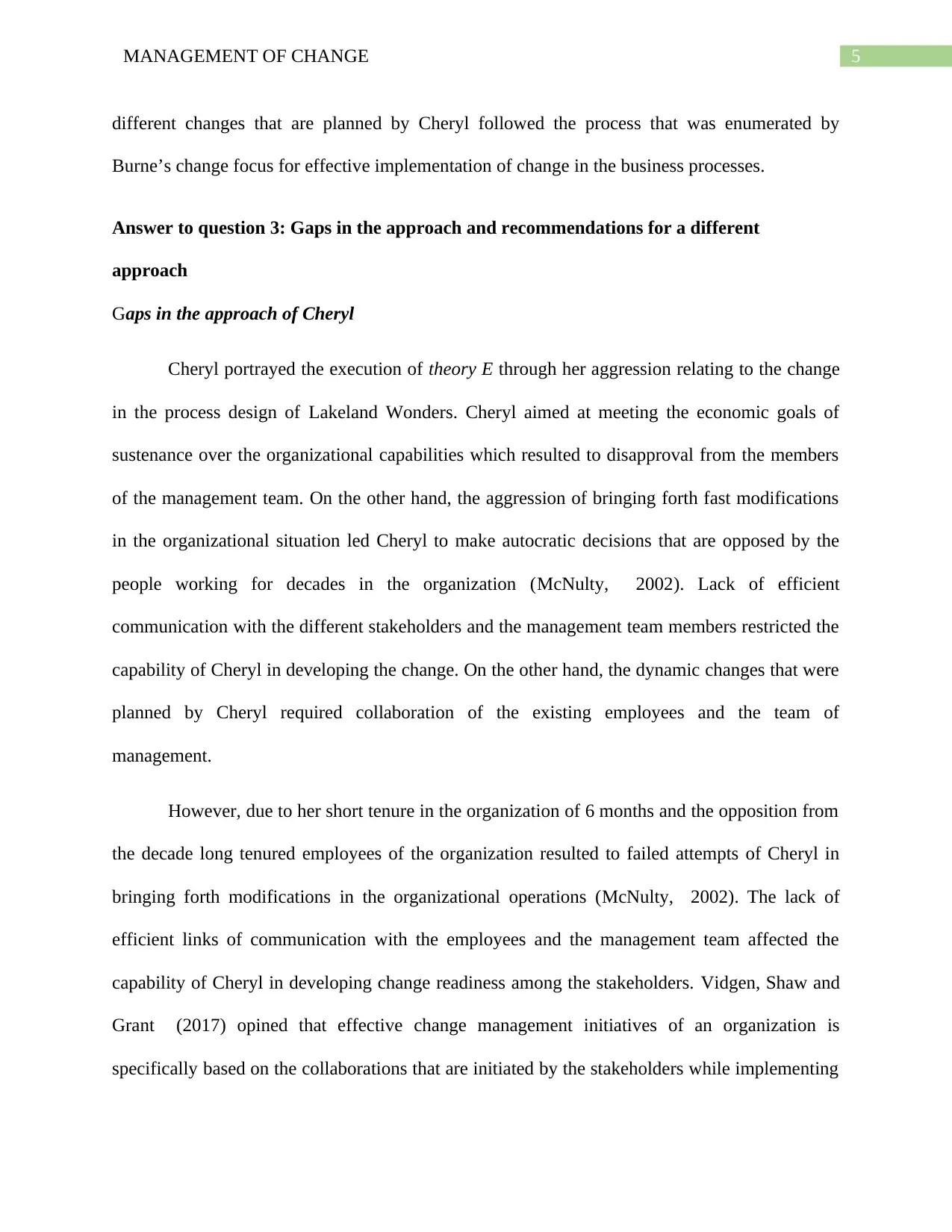
5MANAGEMENT OF CHANGE
different changes that are planned by Cheryl followed the process that was enumerated by
Burne’s change focus for effective implementation of change in the business processes.
Answer to question 3: Gaps in the approach and recommendations for a different
approach
Gaps in the approach of Cheryl
Cheryl portrayed the execution of theory E through her aggression relating to the change
in the process design of Lakeland Wonders. Cheryl aimed at meeting the economic goals of
sustenance over the organizational capabilities which resulted to disapproval from the members
of the management team. On the other hand, the aggression of bringing forth fast modifications
in the organizational situation led Cheryl to make autocratic decisions that are opposed by the
people working for decades in the organization (McNulty, 2002). Lack of efficient
communication with the different stakeholders and the management team members restricted the
capability of Cheryl in developing the change. On the other hand, the dynamic changes that were
planned by Cheryl required collaboration of the existing employees and the team of
management.
However, due to her short tenure in the organization of 6 months and the opposition from
the decade long tenured employees of the organization resulted to failed attempts of Cheryl in
bringing forth modifications in the organizational operations (McNulty, 2002). The lack of
efficient links of communication with the employees and the management team affected the
capability of Cheryl in developing change readiness among the stakeholders. Vidgen, Shaw and
Grant (2017) opined that effective change management initiatives of an organization is
specifically based on the collaborations that are initiated by the stakeholders while implementing
different changes that are planned by Cheryl followed the process that was enumerated by
Burne’s change focus for effective implementation of change in the business processes.
Answer to question 3: Gaps in the approach and recommendations for a different
approach
Gaps in the approach of Cheryl
Cheryl portrayed the execution of theory E through her aggression relating to the change
in the process design of Lakeland Wonders. Cheryl aimed at meeting the economic goals of
sustenance over the organizational capabilities which resulted to disapproval from the members
of the management team. On the other hand, the aggression of bringing forth fast modifications
in the organizational situation led Cheryl to make autocratic decisions that are opposed by the
people working for decades in the organization (McNulty, 2002). Lack of efficient
communication with the different stakeholders and the management team members restricted the
capability of Cheryl in developing the change. On the other hand, the dynamic changes that were
planned by Cheryl required collaboration of the existing employees and the team of
management.
However, due to her short tenure in the organization of 6 months and the opposition from
the decade long tenured employees of the organization resulted to failed attempts of Cheryl in
bringing forth modifications in the organizational operations (McNulty, 2002). The lack of
efficient links of communication with the employees and the management team affected the
capability of Cheryl in developing change readiness among the stakeholders. Vidgen, Shaw and
Grant (2017) opined that effective change management initiatives of an organization is
specifically based on the collaborations that are initiated by the stakeholders while implementing

6MANAGEMENT OF CHANGE
the change to achieve the corporate goals. Therefore, in this relation, Cheryl must have
considered the organizational capabilities for bringing forth the modification over the autocratic
approach of imposing the change aggressively on the organizational model.
Recommendations for a different approach
Cheryl must take steps to encourage the involvement of the different stakeholders
through the introduction of a two- way communication which would enable the stakeholders in
providing feedbacks based on the current change. Heckmann, Steger and Dowling (2016) stated
that gathering feedbacks from the employees enables an organization in identifying the loopholes
of the idea and thereby empower the engagement of the same in the different processes. The
major contributing factors to Cheryl would have been the observation of theory O which
emphasized on organizational capability while undertaking a change. On the other hand, Cheryl
might also make use of the Johari Window for establishing sound communication between the
employees with the purpose of identifying their concerns.
On the other hand, Cheryl might also take steps to undertake frequent meetings with the
different stakeholders while presenting data on the feasibility of the change process and the
benefits that the organization might derive from the smooth implementation of the change in the
organizational processes. Micelotta, Lounsbury and Greenwood (2017) stated that effective
change processes are specifically based on negotiations and thereby developing change readiness
for the greater good of the organization. Cheryl faced resistances from the management teams as
she was unable to reflect on the benefits that the organization might gather from the ne inclusion.
However, Cheryl could have made use of presentable data sheets with the objective of making
the employees aware of the organizational benefits through the change idea. Therefore, the
the change to achieve the corporate goals. Therefore, in this relation, Cheryl must have
considered the organizational capabilities for bringing forth the modification over the autocratic
approach of imposing the change aggressively on the organizational model.
Recommendations for a different approach
Cheryl must take steps to encourage the involvement of the different stakeholders
through the introduction of a two- way communication which would enable the stakeholders in
providing feedbacks based on the current change. Heckmann, Steger and Dowling (2016) stated
that gathering feedbacks from the employees enables an organization in identifying the loopholes
of the idea and thereby empower the engagement of the same in the different processes. The
major contributing factors to Cheryl would have been the observation of theory O which
emphasized on organizational capability while undertaking a change. On the other hand, Cheryl
might also make use of the Johari Window for establishing sound communication between the
employees with the purpose of identifying their concerns.
On the other hand, Cheryl might also take steps to undertake frequent meetings with the
different stakeholders while presenting data on the feasibility of the change process and the
benefits that the organization might derive from the smooth implementation of the change in the
organizational processes. Micelotta, Lounsbury and Greenwood (2017) stated that effective
change processes are specifically based on negotiations and thereby developing change readiness
for the greater good of the organization. Cheryl faced resistances from the management teams as
she was unable to reflect on the benefits that the organization might gather from the ne inclusion.
However, Cheryl could have made use of presentable data sheets with the objective of making
the employees aware of the organizational benefits through the change idea. Therefore, the
Paraphrase This Document
Need a fresh take? Get an instant paraphrase of this document with our AI Paraphraser
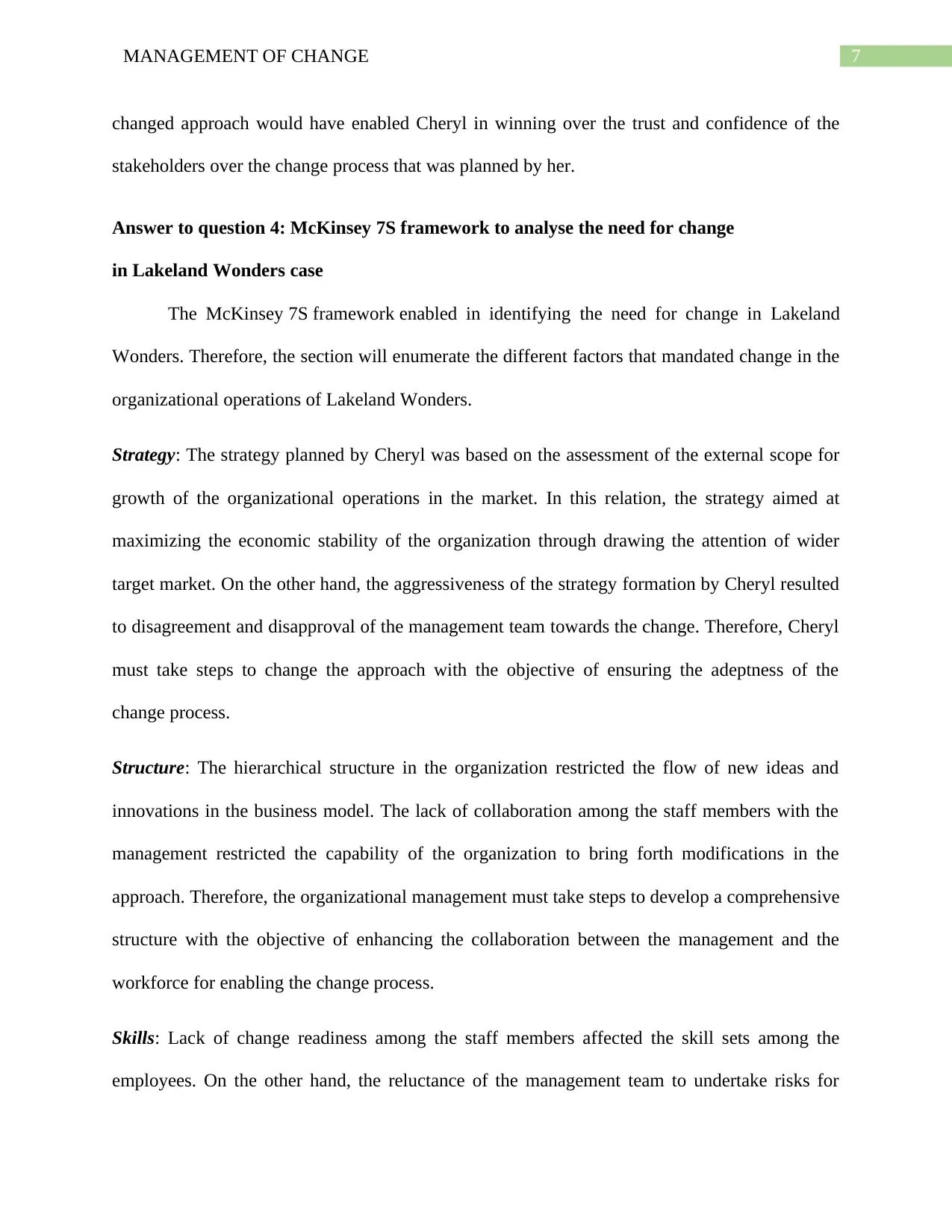
7MANAGEMENT OF CHANGE
changed approach would have enabled Cheryl in winning over the trust and confidence of the
stakeholders over the change process that was planned by her.
Answer to question 4: McKinsey 7S framework to analyse the need for change
in Lakeland Wonders case
The McKinsey 7S framework enabled in identifying the need for change in Lakeland
Wonders. Therefore, the section will enumerate the different factors that mandated change in the
organizational operations of Lakeland Wonders.
Strategy: The strategy planned by Cheryl was based on the assessment of the external scope for
growth of the organizational operations in the market. In this relation, the strategy aimed at
maximizing the economic stability of the organization through drawing the attention of wider
target market. On the other hand, the aggressiveness of the strategy formation by Cheryl resulted
to disagreement and disapproval of the management team towards the change. Therefore, Cheryl
must take steps to change the approach with the objective of ensuring the adeptness of the
change process.
Structure: The hierarchical structure in the organization restricted the flow of new ideas and
innovations in the business model. The lack of collaboration among the staff members with the
management restricted the capability of the organization to bring forth modifications in the
approach. Therefore, the organizational management must take steps to develop a comprehensive
structure with the objective of enhancing the collaboration between the management and the
workforce for enabling the change process.
Skills: Lack of change readiness among the staff members affected the skill sets among the
employees. On the other hand, the reluctance of the management team to undertake risks for
changed approach would have enabled Cheryl in winning over the trust and confidence of the
stakeholders over the change process that was planned by her.
Answer to question 4: McKinsey 7S framework to analyse the need for change
in Lakeland Wonders case
The McKinsey 7S framework enabled in identifying the need for change in Lakeland
Wonders. Therefore, the section will enumerate the different factors that mandated change in the
organizational operations of Lakeland Wonders.
Strategy: The strategy planned by Cheryl was based on the assessment of the external scope for
growth of the organizational operations in the market. In this relation, the strategy aimed at
maximizing the economic stability of the organization through drawing the attention of wider
target market. On the other hand, the aggressiveness of the strategy formation by Cheryl resulted
to disagreement and disapproval of the management team towards the change. Therefore, Cheryl
must take steps to change the approach with the objective of ensuring the adeptness of the
change process.
Structure: The hierarchical structure in the organization restricted the flow of new ideas and
innovations in the business model. The lack of collaboration among the staff members with the
management restricted the capability of the organization to bring forth modifications in the
approach. Therefore, the organizational management must take steps to develop a comprehensive
structure with the objective of enhancing the collaboration between the management and the
workforce for enabling the change process.
Skills: Lack of change readiness among the staff members affected the skill sets among the
employees. On the other hand, the reluctance of the management team to undertake risks for
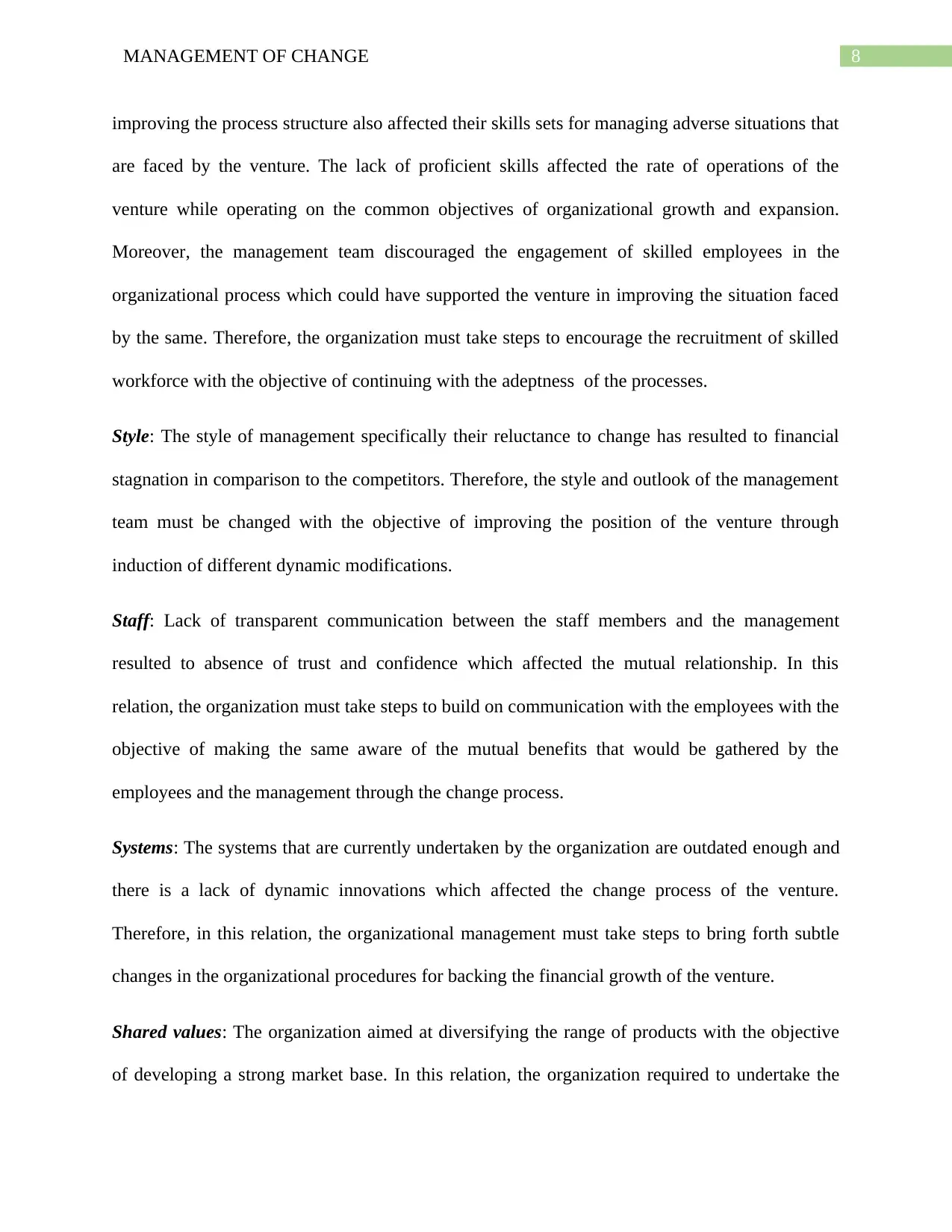
8MANAGEMENT OF CHANGE
improving the process structure also affected their skills sets for managing adverse situations that
are faced by the venture. The lack of proficient skills affected the rate of operations of the
venture while operating on the common objectives of organizational growth and expansion.
Moreover, the management team discouraged the engagement of skilled employees in the
organizational process which could have supported the venture in improving the situation faced
by the same. Therefore, the organization must take steps to encourage the recruitment of skilled
workforce with the objective of continuing with the adeptness of the processes.
Style: The style of management specifically their reluctance to change has resulted to financial
stagnation in comparison to the competitors. Therefore, the style and outlook of the management
team must be changed with the objective of improving the position of the venture through
induction of different dynamic modifications.
Staff: Lack of transparent communication between the staff members and the management
resulted to absence of trust and confidence which affected the mutual relationship. In this
relation, the organization must take steps to build on communication with the employees with the
objective of making the same aware of the mutual benefits that would be gathered by the
employees and the management through the change process.
Systems: The systems that are currently undertaken by the organization are outdated enough and
there is a lack of dynamic innovations which affected the change process of the venture.
Therefore, in this relation, the organizational management must take steps to bring forth subtle
changes in the organizational procedures for backing the financial growth of the venture.
Shared values: The organization aimed at diversifying the range of products with the objective
of developing a strong market base. In this relation, the organization required to undertake the
improving the process structure also affected their skills sets for managing adverse situations that
are faced by the venture. The lack of proficient skills affected the rate of operations of the
venture while operating on the common objectives of organizational growth and expansion.
Moreover, the management team discouraged the engagement of skilled employees in the
organizational process which could have supported the venture in improving the situation faced
by the same. Therefore, the organization must take steps to encourage the recruitment of skilled
workforce with the objective of continuing with the adeptness of the processes.
Style: The style of management specifically their reluctance to change has resulted to financial
stagnation in comparison to the competitors. Therefore, the style and outlook of the management
team must be changed with the objective of improving the position of the venture through
induction of different dynamic modifications.
Staff: Lack of transparent communication between the staff members and the management
resulted to absence of trust and confidence which affected the mutual relationship. In this
relation, the organization must take steps to build on communication with the employees with the
objective of making the same aware of the mutual benefits that would be gathered by the
employees and the management through the change process.
Systems: The systems that are currently undertaken by the organization are outdated enough and
there is a lack of dynamic innovations which affected the change process of the venture.
Therefore, in this relation, the organizational management must take steps to bring forth subtle
changes in the organizational procedures for backing the financial growth of the venture.
Shared values: The organization aimed at diversifying the range of products with the objective
of developing a strong market base. In this relation, the organization required to undertake the

9MANAGEMENT OF CHANGE
change with the objective of improving the financial position of the same through increased sales
volume.
Figure: McKinsey 7S framework
(Source: Schumacher et al., 2016)
Answer to question 5: Organisational culture in the Lakeland Wonders case
The organization, Lakeland Wonders, followed a collectivist culture where all the
decisions were made after consultation with the management team. The collaborative functioning
of the different managers enabled the venture in improving the operations while adhering to the
corporate goals. On the other hand, the individualistic culture of Cheryl while determining the
decisions in favour of the organization increased chances of clash among the stakeholders and
the new CEO of the concerned organization (McNulty, 2002). The different changes in the
approach and mental setup of the managers and the lack of collaborative functioning of Cheryl as
change with the objective of improving the financial position of the same through increased sales
volume.
Figure: McKinsey 7S framework
(Source: Schumacher et al., 2016)
Answer to question 5: Organisational culture in the Lakeland Wonders case
The organization, Lakeland Wonders, followed a collectivist culture where all the
decisions were made after consultation with the management team. The collaborative functioning
of the different managers enabled the venture in improving the operations while adhering to the
corporate goals. On the other hand, the individualistic culture of Cheryl while determining the
decisions in favour of the organization increased chances of clash among the stakeholders and
the new CEO of the concerned organization (McNulty, 2002). The different changes in the
approach and mental setup of the managers and the lack of collaborative functioning of Cheryl as
Secure Best Marks with AI Grader
Need help grading? Try our AI Grader for instant feedback on your assignments.

10MANAGEMENT OF CHANGE
per the existing corporate culture affected the safe implementation of the change strategy. The
nature of the change that was planned by Cheryl was dynamic and transformational by nature
apart from her aggressiveness towards bringing forth a sudden aggressiveness towards improving
the business’ economic sustenance. The introduction of new line of products would enable the
organization in increasing the customer base. On the other hand, Cheryl planned to develop the
production process through outsourcing the design to the foreign organizations which would
enable Lakeland Wonders in minimizing the rate of risk occurrence through even distribution of
uncertainties.
Moreover, the organization relied on the efficient skills and knowledge of the existing
employees over the newly appointed CEO, Cheryl, which introduced conflicts and resistance
from the side of the stakeholders (McNulty, 2002). Creasey et al. (2016) stated that the
organizational structure and culture examines the changes that are initiated by the organizations.
K. Smith et al. (2017) opined that organizational change is chiefly reliant on the effective
engagement of the stakeholders in the processes. In this relation, Cheryl might take steps to
encourage the involvement of the stakeholders in the decision making process for permitting the
smooth implementation of the radical change in the organizational process.
The absence of innovative ideas in the organizational model restricted the scope of
expansion while maximizing the profitability through targeting a wider market segment. The
hierarchical form of management in the organization and the collaborative functioning related
culture was dismantled through the aggressive decision making process of Cheryl which created
dismay among the stakeholders. The major traits of organizational culture of Lakeland Wonders
is reflected through the lack of change readiness among the stakeholders, including the team of
per the existing corporate culture affected the safe implementation of the change strategy. The
nature of the change that was planned by Cheryl was dynamic and transformational by nature
apart from her aggressiveness towards bringing forth a sudden aggressiveness towards improving
the business’ economic sustenance. The introduction of new line of products would enable the
organization in increasing the customer base. On the other hand, Cheryl planned to develop the
production process through outsourcing the design to the foreign organizations which would
enable Lakeland Wonders in minimizing the rate of risk occurrence through even distribution of
uncertainties.
Moreover, the organization relied on the efficient skills and knowledge of the existing
employees over the newly appointed CEO, Cheryl, which introduced conflicts and resistance
from the side of the stakeholders (McNulty, 2002). Creasey et al. (2016) stated that the
organizational structure and culture examines the changes that are initiated by the organizations.
K. Smith et al. (2017) opined that organizational change is chiefly reliant on the effective
engagement of the stakeholders in the processes. In this relation, Cheryl might take steps to
encourage the involvement of the stakeholders in the decision making process for permitting the
smooth implementation of the radical change in the organizational process.
The absence of innovative ideas in the organizational model restricted the scope of
expansion while maximizing the profitability through targeting a wider market segment. The
hierarchical form of management in the organization and the collaborative functioning related
culture was dismantled through the aggressive decision making process of Cheryl which created
dismay among the stakeholders. The major traits of organizational culture of Lakeland Wonders
is reflected through the lack of change readiness among the stakeholders, including the team of

11MANAGEMENT OF CHANGE
management. In this relation, the lack of change readiness among the stakeholders incapacitated
the organization in driving positive changes in favour of the organizational sustenance.
It has been noted during the case review that the changes that were proposed by Cheryl
emphasized on the financial sustenance (McNulty, 2002). However, the lack of change readiness
among the stakeholders, especially the team of management affected the idea of dynamic change
in the organizational model. Razmerita, Kirchner and Nielsen (2016) stated that the different
changes on the organizational operations are related to the active participation of the employees
in the different organizational change processes. However, the lack of change readiness related
culture in the chosen organization restricted the capability of Cheryl in forging modifications for
supporting the growth and expansion of the venture.
management. In this relation, the lack of change readiness among the stakeholders incapacitated
the organization in driving positive changes in favour of the organizational sustenance.
It has been noted during the case review that the changes that were proposed by Cheryl
emphasized on the financial sustenance (McNulty, 2002). However, the lack of change readiness
among the stakeholders, especially the team of management affected the idea of dynamic change
in the organizational model. Razmerita, Kirchner and Nielsen (2016) stated that the different
changes on the organizational operations are related to the active participation of the employees
in the different organizational change processes. However, the lack of change readiness related
culture in the chosen organization restricted the capability of Cheryl in forging modifications for
supporting the growth and expansion of the venture.

12MANAGEMENT OF CHANGE
References
Baumgartner, R. J., & Rauter, R. (2017). Strategic perspectives of corporate sustainability
management to develop a sustainable organization. Journal of Cleaner Production, 140,
81-92.
Beech, N., MacIntosh, R., Krust, P., Kannan, S. B & Dadich, A. (2018). Managing change:
enquiry and action. Australasian edition. Cambridge: Cambridge University Press
Creasey, T., Jamieson, D. W., Rothwell, W. J., & Severini, G. (2016). Exploring the relationship
between organization development and change management. Practicing organization
development: Leading transformation and change (4th ed., pp. 330-337). Hoboken, NJ:
John Wiley & Sons.
Cummings, S., Bridgman, T., & Brown, K. G. (2016). Unfreezing change as three steps:
Rethinking Kurt Lewin’s legacy for change management. Human relations, 69(1), 33-60.
Fernandez, S., & Rainey, H. G. (2017). Managing successful organizational change in the public
sector. In Debating Public Administration (pp. 7-26). Routledge.
Heckmann, N., Steger, T., & Dowling, M. (2016). Organizational capacity for change, change
experience, and change project performance. Journal of Business Research, 69(2), 777-
784.
Imran, M. K., Rehman, C. A., Aslam, U., & Bilal, A. R. (2016). What’s organization knowledge
management strategy for successful change implementation?. Journal of Organizational
Change Management, 29(7), 1097-1117.
References
Baumgartner, R. J., & Rauter, R. (2017). Strategic perspectives of corporate sustainability
management to develop a sustainable organization. Journal of Cleaner Production, 140,
81-92.
Beech, N., MacIntosh, R., Krust, P., Kannan, S. B & Dadich, A. (2018). Managing change:
enquiry and action. Australasian edition. Cambridge: Cambridge University Press
Creasey, T., Jamieson, D. W., Rothwell, W. J., & Severini, G. (2016). Exploring the relationship
between organization development and change management. Practicing organization
development: Leading transformation and change (4th ed., pp. 330-337). Hoboken, NJ:
John Wiley & Sons.
Cummings, S., Bridgman, T., & Brown, K. G. (2016). Unfreezing change as three steps:
Rethinking Kurt Lewin’s legacy for change management. Human relations, 69(1), 33-60.
Fernandez, S., & Rainey, H. G. (2017). Managing successful organizational change in the public
sector. In Debating Public Administration (pp. 7-26). Routledge.
Heckmann, N., Steger, T., & Dowling, M. (2016). Organizational capacity for change, change
experience, and change project performance. Journal of Business Research, 69(2), 777-
784.
Imran, M. K., Rehman, C. A., Aslam, U., & Bilal, A. R. (2016). What’s organization knowledge
management strategy for successful change implementation?. Journal of Organizational
Change Management, 29(7), 1097-1117.
Paraphrase This Document
Need a fresh take? Get an instant paraphrase of this document with our AI Paraphraser

13MANAGEMENT OF CHANGE
K. Smith, W., Erez, M., Jarvenpaa, S., Lewis, M. W., & Tracey, P. (2017). Adding complexity to
theories of paradox, tensions, and dualities of innovation and change: Introduction to
organization studies special issue on paradox, tensions, and dualities of innovation and
change.
McNulty, E. (2002). Welcome Aboard (But Don’t Change a Thing). [online] Harvard Business
Review. Available at: https://hbr.org/2002/10/welcome-aboard-but-dont-change-a-thing
[Accessed 4 Sep. 2019].
Micelotta, E., Lounsbury, M., & Greenwood, R. (2017). Pathways of institutional change: An
integrative review and research agenda. Journal of Management, 43(6), 1885-1910.
Razmerita, L., Kirchner, K., & Nielsen, P. (2016). What factors influence knowledge sharing in
organizations? A social dilemma perspective of social media communication. Journal of
knowledge Management, 20(6), 1225-1246.
Schumacher, D., Schreurs, B., Van Emmerik, H., & De Witte, H. (2016). Explaining the relation
between job insecurity and employee outcomes during organizational change: A multiple
group comparison. Human Resource Management, 55(5), 809-827.
Stephan, U., Patterson, M., Kelly, C., & Mair, J. (2016). Organizations driving positive social
change: A review and an integrative framework of change processes. Journal of
Management, 42(5), 1250-1281.
Vaara, E., Sonenshein, S., & Boje, D. (2016). Narratives as sources of stability and change in
organizations: approaches and directions for future research. Academy of Management
Annals, 10(1), 495-560.
K. Smith, W., Erez, M., Jarvenpaa, S., Lewis, M. W., & Tracey, P. (2017). Adding complexity to
theories of paradox, tensions, and dualities of innovation and change: Introduction to
organization studies special issue on paradox, tensions, and dualities of innovation and
change.
McNulty, E. (2002). Welcome Aboard (But Don’t Change a Thing). [online] Harvard Business
Review. Available at: https://hbr.org/2002/10/welcome-aboard-but-dont-change-a-thing
[Accessed 4 Sep. 2019].
Micelotta, E., Lounsbury, M., & Greenwood, R. (2017). Pathways of institutional change: An
integrative review and research agenda. Journal of Management, 43(6), 1885-1910.
Razmerita, L., Kirchner, K., & Nielsen, P. (2016). What factors influence knowledge sharing in
organizations? A social dilemma perspective of social media communication. Journal of
knowledge Management, 20(6), 1225-1246.
Schumacher, D., Schreurs, B., Van Emmerik, H., & De Witte, H. (2016). Explaining the relation
between job insecurity and employee outcomes during organizational change: A multiple
group comparison. Human Resource Management, 55(5), 809-827.
Stephan, U., Patterson, M., Kelly, C., & Mair, J. (2016). Organizations driving positive social
change: A review and an integrative framework of change processes. Journal of
Management, 42(5), 1250-1281.
Vaara, E., Sonenshein, S., & Boje, D. (2016). Narratives as sources of stability and change in
organizations: approaches and directions for future research. Academy of Management
Annals, 10(1), 495-560.
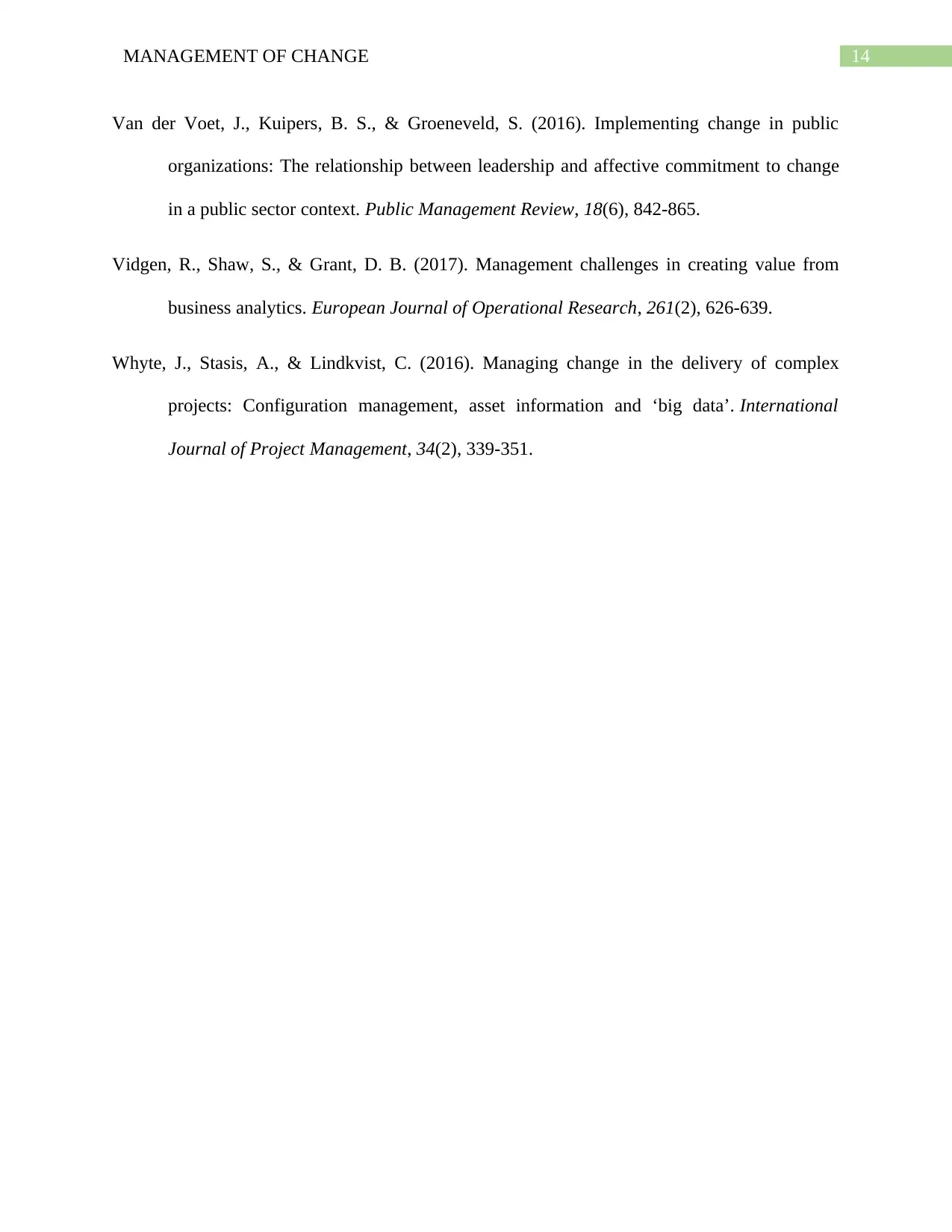
14MANAGEMENT OF CHANGE
Van der Voet, J., Kuipers, B. S., & Groeneveld, S. (2016). Implementing change in public
organizations: The relationship between leadership and affective commitment to change
in a public sector context. Public Management Review, 18(6), 842-865.
Vidgen, R., Shaw, S., & Grant, D. B. (2017). Management challenges in creating value from
business analytics. European Journal of Operational Research, 261(2), 626-639.
Whyte, J., Stasis, A., & Lindkvist, C. (2016). Managing change in the delivery of complex
projects: Configuration management, asset information and ‘big data’. International
Journal of Project Management, 34(2), 339-351.
Van der Voet, J., Kuipers, B. S., & Groeneveld, S. (2016). Implementing change in public
organizations: The relationship between leadership and affective commitment to change
in a public sector context. Public Management Review, 18(6), 842-865.
Vidgen, R., Shaw, S., & Grant, D. B. (2017). Management challenges in creating value from
business analytics. European Journal of Operational Research, 261(2), 626-639.
Whyte, J., Stasis, A., & Lindkvist, C. (2016). Managing change in the delivery of complex
projects: Configuration management, asset information and ‘big data’. International
Journal of Project Management, 34(2), 339-351.
1 out of 15
Related Documents
Your All-in-One AI-Powered Toolkit for Academic Success.
+13062052269
info@desklib.com
Available 24*7 on WhatsApp / Email
![[object Object]](/_next/static/media/star-bottom.7253800d.svg)
Unlock your academic potential
© 2024 | Zucol Services PVT LTD | All rights reserved.





